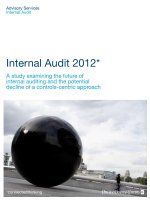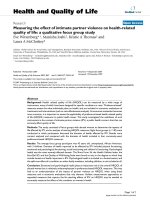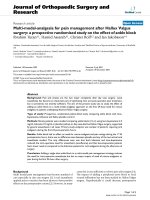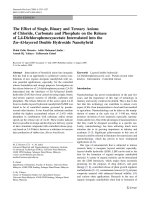A study on the effect of squish area on engine performance of single cylinder natural gas converted engine
Bạn đang xem bản rút gọn của tài liệu. Xem và tải ngay bản đầy đủ của tài liệu tại đây (1.08 MB, 8 trang )
JST: Engineering and Technology for Sustainable Development
Volume 32, Issue 2, April 2022, 032-039
A Study on the Effect of Squish Area on Engine Performance
of Single Cylinder Natural Gas Converted Engine
Van Tien Nguyen, Tran Dang Quoc*
School of Transportation Engineering, Hanoi University of Science and Technology, Hanoi, Vietnam
*
Email:
Abstract
Today, the prices of fossil fuels such as gasoline and diesel are skyrocketing, oil depletion and air pollution
are major challenges for us and the auto industry in particular. Natural gas has known as a potential alternative
fuel for internal combustion engines because of its advantages such as the octane number, which is higher
than that of gasoline, the low heat value which is higher in comparison with gasoline and diesel and the safety
in use. This paper presents a study on the influence of squish area on engine performance of single cylinder
natural gas converted engine. The obtained results indicated that the increase of compression ratio only
augmented the risk of knocking for single cylinder natural gas converted engine. Conversely, the modification
of bowl-in-piston is directly varied squish area, thus the turbulent kinetic energy of the gas flows at the end of
the compression stroke increased in comparison with the flat head piston of the original engine.
Keywords: Natural gas, piston geometry, engine performance, converted engine.
1. Introduction *
In recent decades, the economic growth of the
world has led to the rapid increase of internal
combustion engines [1]. Rising concerns about
emissions have put great strain on the automotive
industry. As a result, the industry is looking for nextgeneration engines and advanced combustion
technology with extremely low emissions and high
efficiency [2]. To achieve this, more understanding of
combustion and mixture formation inside the cylinder
is needed [3]. The research direction, using
Compressed Natural Gas (CNG) as fuel for internal
combustion engines has solved several problems such
as: saving fossil fuels to ensure energy security,
limiting emissions of greenhouse gases, protecting the
environment, production, traffic, and daily life [4]. The
main component of natural gas is methane (CH4)
accounting for 85-96%, the rest is a small amount of
ethane (C2H6), propane (C3H8), butane (C4H10), and
a small number of other gases [5]. The emissions in
combustion process products such as CO, particulate
matter (PM), and NOx will be lower because of cleaner
combustion and the combustions do not produce CH4
emissions, as CH4 is the main component [4].
In Viet Nam, the use of natural gas as fuel for
internal combustion engines has gradually expanded
and developed. The solution to convert a traditional
diesel engine into a forced-ignition natural gas engine
on the one hand allows taking advantage of the diesel
engine's low speed and high compression ratio to
improve engine performance with new fuel, on the
other hand, solving the problem of production costs of
new CNG engines. Due to natural gas existing in the
form of gas, natural gas will be easier to mix with the
air than liquid fuel (gasoline and diesel), so the amount
of fuel loaded into the engine cylinder will burn more
easily [7]. In addition, during operation, it does not
consume liquid fuel to inject primer [8]. This helps to
improve economic efficiency when using natural gas
engines. However, because the fuel characteristics of
CNG are different from the fuel form of traditional
Diesel. Therefore, exploiting and using optimally the
performance of the post-conversion engine is an
extremely important issue. The aim of this study is to
analyze the effect of bowl-in-piston on the
performance of a converted Diesel engine using CNG
fuel forced combustion - SING engine. From the above
issues, it shows that this research is necessary for
today's actual situation.
2. Theoretical Framework
A theoretical squish velocity can be calculated
from the instantaneous displacement of gas across the
inner edge of the squish region (across the dash lines
in the drawings in Fig. 1). The original diesel engine’s
cylinder head and piston top are both flat. Ignoring the
effects of gas dynamics (non-uniform pressure),
frictions, leakage past the piston rings, and heat
transfer, the squish velocity’s expression is
𝑣𝑣𝑠𝑠𝑠𝑠
𝐷𝐷𝑏𝑏 𝐵𝐵 2
𝑉𝑉𝑏𝑏
=
�� � − 1�
𝑆𝑆𝑝𝑝
4𝑧𝑧 𝐷𝐷𝑏𝑏
𝐴𝐴𝑐𝑐 𝑧𝑧 + 𝑉𝑉𝑏𝑏
ISSN 2734-9381
/>Received: March 8, 2022; accepted: April 1, 2022
32
(1)
JST: Engineering and Technology for Sustainable Development
Volume 32, Issue 2, April 2022, 032-039
𝜕𝜕𝜕𝜕
𝜕𝜕𝜕𝜕
+ 𝑢𝑢�𝚥𝚥
𝜕𝜕𝜕𝜕
𝜕𝜕𝑥𝑥𝑖𝑖
=−
�������������
�������
1 𝜕𝜕𝑢𝑢′
1 𝜕𝜕𝑢𝑢′
𝚥𝚥 𝑢𝑢′𝚥𝚥 𝑢𝑢′𝚤𝚤
𝚤𝚤 𝑝𝑝′
−
+
𝜕𝜕𝑥𝑥𝑖𝑖
𝜌𝜌0 𝜕𝜕𝑥𝑥𝑖𝑖
2
𝑣𝑣
where 𝑉𝑉𝑏𝑏 is the volume of the piston bowl (𝑚𝑚3 ), 𝐴𝐴𝑐𝑐 is
the cross-sectional area of the cylinder (𝑚𝑚2 ), 𝑆𝑆𝑝𝑝 is the
instantaneous piston speed (𝑣𝑣 2 /𝑚𝑚), z is the distance
between the piston crown top and the cylinder head
(m), l is connecting rod length (m), a: the crank radius
(m), s is the distance between the crank axis and the
piston pin axis, c: the clearance height, 𝐷𝐷𝑏𝑏 : the
diameter of the bowl, 𝐻𝐻𝑏𝑏 : the depth of the bowl.
𝜕𝜕2 𝑘𝑘
𝜕𝜕𝑥𝑥𝑗𝑗2
���
𝜕𝜕𝑢𝑢
𝚤𝚤
′ 𝑢𝑢 ′
�������
− 𝑢𝑢
𝚤𝚤 𝚥𝚥 𝜕𝜕𝑥𝑥 − 𝑣𝑣
𝑗𝑗
′ 𝜕𝜕𝑢𝑢′
����������
𝜕𝜕𝑢𝑢
𝚤𝚤
𝚤𝚤
𝜕𝜕𝑥𝑥𝚥𝚥 𝜕𝜕𝑥𝑥𝚥𝚥
−
𝑔𝑔 ������
𝜌𝜌′𝑢𝑢′𝚤𝚤 𝛿𝛿𝑖𝑖3
𝜌𝜌0
(2)
An important parameter that also needs to be
considered and evaluated through measurement
parameters to evaluate the quality of combustion is
Mass Fraction Burned (MFB). The value of MFB is
calculated based on the ratio between the accumulated
heat of the fuel released from the combustion process
to the total theoretical heat of the fuel injected into the
engine cylinder. The burned fuel mass factor is a
function that varies with the crankshaft rotation angle,
the formula is as follows:
𝑀𝑀𝑀𝑀𝑀𝑀 =
𝛿𝛿𝑄𝑄𝑔𝑔𝑔𝑔𝑔𝑔
𝜃𝜃
�
�𝑑𝑑𝑑𝑑
𝑑𝑑𝑑𝑑
𝑠𝑠𝑠𝑠𝑐𝑐
∫𝜃𝜃
(3)
𝑚𝑚𝑓𝑓,𝑡𝑡𝑡𝑡𝑡𝑡𝑡𝑡𝑡𝑡 × 𝜂𝜂𝑐𝑐𝑐𝑐𝑐𝑐𝑐𝑐 × 𝑄𝑄𝐿𝐿𝐿𝐿𝐿𝐿
Where: MFB is Mass Fraction Burn; θ is the crankshaft
rotation angle (radial); 𝑄𝑄𝑔𝑔𝑔𝑔𝑔𝑔 is the total theoretical heat
of the fuel injected (kJ); 𝑚𝑚𝑓𝑓,𝑡𝑡𝑡𝑡𝑡𝑡𝑡𝑡𝑡𝑡 is the total intake fuel
mass (g/s); 𝜂𝜂𝑐𝑐𝑐𝑐𝑐𝑐𝑐𝑐 is thermal efficiency; 𝑄𝑄𝐿𝐿𝐿𝐿𝐿𝐿 is the low
heating value, (kJ/kg).
Fig. 1. Schematic of the bowl-in-piston chamber and
squish area.
Turbulent Kinetic Energy (TKE) is the average
kinetic energy per unit mass with circular swirls of
turbulent flow. This vortex tends to run into large
spaces and has lower pressure. For the refrigerant flow
inside the engine cylinder with stable viscosity, the
turbulent kinetic energy (TKE) equation of the
refrigerant flow inside the engine cylinder of the
mixture of air and natural gas is written as equation (2):
where:
advection;
𝜕𝜕𝜕𝜕
is
𝜕𝜕𝜕𝜕
�������
1 𝜕𝜕𝑢𝑢′
𝚤𝚤 𝑝𝑝′
𝜌𝜌0
𝜕𝜕𝑥𝑥𝑖𝑖
local
derivative; 𝑢𝑢�𝚥𝚥
is pressure diffusion;
turbulent transport (T); 𝑣𝑣
𝜕𝜕2 𝑘𝑘
𝜕𝜕𝑥𝑥𝑥𝑥𝑗𝑗2
𝜕𝜕𝜕𝜕
𝜕𝜕𝑥𝑥𝑖𝑖
�������������
1 𝜕𝜕𝑢𝑢′
𝚥𝚥 𝑢𝑢′𝚥𝚥 𝑢𝑢′𝚤𝚤
2
𝜕𝜕𝑥𝑥𝑖𝑖
is
is
is molecular viscous
���������
���𝚤𝚤
𝜕𝜕𝑢𝑢
𝜕𝜕𝑢𝑢′ 𝜕𝜕𝑢𝑢′
�������
transport.; −𝑢𝑢′
is production (P); 𝑣𝑣 𝚤𝚤 𝚤𝚤 is
𝚤𝚤 𝑢𝑢′𝚥𝚥
dissipation (ℇ𝑘𝑘 );
𝑔𝑔
𝜌𝜌0
𝜕𝜕𝑥𝑥𝑗𝑗
𝜕𝜕𝑥𝑥𝚥𝚥 𝜕𝜕𝑥𝑥𝚥𝚥
������
𝜌𝜌′ 𝑢𝑢′𝚤𝚤 𝛿𝛿𝑖𝑖3 is buoyancy flux (b).
Heat release rate (HRR) is the rate at which heat
is released during the combustion of fuel in an engine
cylinder. Based on the HRR value, it is possible to
evaluate the characteristics of the fuel combustion
process inside the engine cylinder and diagnose the
composition of the exhaust gases formed. The heat
release rate is calculated based on the 1st law of
thermodynamics with the non-dimensional and mixed
kinematics model in a single-zone cylinder, from the
pressure parameter in the cylinder measured at 100
cycles, the HRR can be calculated according to the
following general formula:
𝑑𝑑𝑄𝑄𝑐𝑐
𝑑𝑑𝑑𝑑
𝛾𝛾
𝑑𝑑𝑑𝑑
�
𝛾𝛾−1 𝑑𝑑𝑑𝑑
= 𝑃𝑃 �
𝑑𝑑𝑄𝑄
1
𝑑𝑑𝑑𝑑
�
𝛾𝛾−1 𝑑𝑑𝑑𝑑
+ 𝑉𝑉 �
+
𝑑𝑑𝑄𝑄ℎ
𝑑𝑑𝑑𝑑
(4)
where: 𝑐𝑐 is heat released from combustion process
𝑑𝑑𝜃𝜃
in engine cylinder.
𝑑𝑑𝑄𝑄ℎ
𝑑𝑑𝑑𝑑
is heat transfer to wall of combustion
chamber.
To prevent the auto-ignition phenomenon in
spark-ignition engines, it is needed to determine the
knocking limit by combining the maximum pressure
value and the required octane number (ON). The
required octane number is considered as the
following formula
𝑛𝑛
1
𝑎𝑎
1 𝑡𝑡85%𝑀𝑀𝑀𝑀𝑀𝑀
𝑝𝑝
𝐵𝐵
𝑂𝑂𝑂𝑂 = 100. � �
��
� . 𝑒𝑒𝑒𝑒𝑒𝑒 �−
�� 𝑑𝑑𝑑𝑑�
𝐴𝐴 𝑡𝑡𝑆𝑆𝑆𝑆𝑆𝑆
𝑝𝑝𝑅𝑅𝑅𝑅 𝑓𝑓
𝑇𝑇𝑈𝑈𝑈𝑈𝑈𝑈
33
(5)
JST: Engineering and Technology for Sustainable Development
Volume 32, Issue 2, April 2022, 032-039
3. Engine Simulating, Calibration and Controlling
Model
3.1. Experimental Setup
Experimental setup is an important step to collect
the parameters on the test bench, which will be used to
calibrate the model. Research equipment and engine
were arranged as shown in Fig. 2 and 3, including the
following equipment: Ricardo single-cylinder research
engine redesigned from a horizontal single-cylinder
diesel engine with the parameters presented in Table 1.
The CNG fuel supply system (Mass Flow Controller:
MFC) and a port CNG injector, a Dynamometer was
used to measure the engine’s torque, in addition, there
were the intake/exhaust system, the cooler system, the
engine control unit, the data collector and others
measuring systems.
Table 1. Basic parameters of QTC2015
Parameter
Symbols
Value
Bore, (mm)
D
103
Stroke, (mm)
S
115
Injector (-)
i
1
Number of Stroke
(-)
T
4
Compression ratio
E
9-35
3.2. Simulating Theoretical Framework
The Fractal Combustion Model was selected as
the research model for the mixed charge flow from the
AVL Boost software’s library. This was the suitable
model for CI engines [9], the theoretical framework is
summarized below.
Ignition timing was considered as the start of the
combustion of simulation. The flame front formation
was the parameter to calibrate the ignition delay (𝐶𝐶𝑖𝑖𝑖𝑖𝑖𝑖 ).
The flame propagation speed was the parameter to
calibrate the ignition delay (𝑟𝑟𝑓𝑓,𝑟𝑟𝑟𝑟𝑟𝑟 ). The burned mass
of fuel in a time unit was calculated as the formula:
𝑑𝑑𝑑𝑑𝑏𝑏
𝑑𝑑𝑑𝑑
𝐿𝐿
= 𝜌𝜌𝑢𝑢 � 1 �
𝑙𝑙𝑘𝑘
𝐷𝐷 −2
𝜌𝜌𝑠𝑠𝑠𝑠𝑠𝑠 𝑚𝑚 3
𝜌𝜌𝑢𝑢𝑢𝑢
� �
(6)
× 𝐴𝐴𝐿𝐿 × 𝑆𝑆𝐿𝐿
where: 𝑚𝑚 is the calibration parameter of turbulence
model; 𝜌𝜌𝑠𝑠𝑠𝑠𝑠𝑠 is the unburn density at the start of
combustion; 𝜌𝜌𝑢𝑢𝑢𝑢 is the unburn density.
The small amount of burned mass at the start
of wall combustion determined in-wall combustion
𝑚𝑚
process was � 𝑏𝑏 � , where the transition time 𝑡𝑡𝑡𝑡𝑡𝑡 has
𝑚𝑚
𝑡𝑡𝑡𝑡
been determined when a small amount of mass
was burned. The laminar burning speed
𝑑𝑑
𝑆𝑆𝐿𝐿 = 𝑐𝑐𝑙𝑙𝑙𝑙𝑙𝑙 𝑆𝑆𝐿𝐿,𝑅𝑅𝑅𝑅=0 �1 − 𝑚𝑚𝑓𝑓𝑓𝑓𝑓𝑓 � has been determined at
the start of wall combustion (𝑑𝑑), allowed to adjust
more 𝑆𝑆𝐿𝐿 depending on residual gas mass coefficiency
(𝑚𝑚𝑓𝑓𝑓𝑓𝑓𝑓 ).
Fig. 4 presented the elements of the QTC 2015
engine simulated by AVL Boost software, each
element of the simulation engine had the same
parameters as the experimental engine.
Based on the QTC2015 engine structural
parameters, CNG test fuel and AVL Boost software
manual, the one-way model of the engine is shown on
Fig. 4, and annotation of the elements in Table 2.
Table 2. Element name of the simulated motor
Fig. 2. Scheme of the experimental equipment setup
Fig. 3. Engine and experimental equipment
34
Element name
Symbols
Amount
Engine
E
1
Cylinder
C
1
Air filter
CL
1
Throttle
TH
1
Injector
I
1
Plenum
PL
1
Measuring points
MP
7
Restriction
R
3
System Boundary
SB
2
Pipes
→
8
JST: Engineering and Technology for Sustainable Development
Volume 32, Issue 2, April 2022, 032-039
Fig. 4. The simulation engine QTC2015
3.2. Model Calibration
Fig. 5 presented the results such as torque (Me)
and power (Ne) of the experimental and simulation
engine, with the solid lines were the results of the real
engine on the test bench. The dash lines represented
the simulation model’s results after recalibrating the
model. However, the parameters of QTC2015
experimental engine such as cylinder bore, piston
parameters, stroke, lengths, and diameters of intake
and exhaust ports were used to input for the model.
The experimental condition of the test engine is
wide-open throttle (WOT) so this element
wasn’t used in the model, spark angle was adjusted
before top dead center (IT: BTDC) and compression
ratio is ɛ = 10. Considering the whole experimental
zone (n = 1000 - 2000 rpm), the maximum and
minimum errors between the simulation results and
experimental results were about 5% and 2%. However,
at the speed n = 1800 rpm, the errors of both torque
and power were approximately 2% and this speed was
fixed to study the influences of the structuring
parameters on combustion duration.
3.3. Controlling the Model
Fig. 5. The calibration results of the model
speed is n = 1800 rpm, λ is constant, ignition timing is
chosen to achieve the maximum brake torque
IT = MBT.
Table 3. Structuring parameters of study piston
Piston
types
Heron 1
Bowl Diameter
(Db, mm)
60
Bowl Depth
(Hb, mm)
10
Heron 2
60
17
Heron 3
66
17
The shape of the piston top structure of this study
will be selected based on the point of view of creating
turbulent kinetic energy of the gas flow at the end of
the compression stroke and safe during engine
operation. Structuring parameters of the four-piston
peaks that will be used in this study are presented in
Table 3.
4. Results and Discussions
4.1. Compression Ratio Selection for Converted
Engine
To consider the effect of the bowl in piston on
the piston top on the SING engine’s performance, the
simulation study will be proceeded as follows: the port
injection pressure is kept constantly with Pf = 1, the
throttle is fully opened (Throttle: WOT) to reduce the
losses.
Diesel engines usually have a high compression
ratio, and the shape of the combustion chamber
depends mainly on the geometric size of the piston top,
so when converting into a natural gas spark
combustion engine it is necessary to study and
consider decreasing the compression ratio to avoid the
knocking occurrence [10].
The center of the bowl volume on the top of the
piston top and the spark plug center coincides with the
center line of the engine cylinder. Structuring
parameters were varied: the bowl depth with Hb = 0
(Piston shape: Flat), Hb = 10 mm and Hb = 17 mm.
Meanwhile, the bowl diameter was varied: Db = 0
(Flat-peak piston), Db = 60 mm and Db = 66 mm.
Engine speeds were varied: n = 1000-2200 rpm with
a step n = 200. The compression ratio ɛ = 10-15
changed until the ON value > 130 then stopped. To
study the effect of bowl in piston on the combustion
and heating characteristics in the cylinder, the engine
Fig. 6 presented the effect of engine speed on the
required Octane Number (ON) of six different
compression ratios (𝜀𝜀 = 10, 11, 12, 13, 14 and 15)
under the same working conditions: fuel injection
pressure is Pf = 1 bar and λ = 1, the head geometry of
piston is flat, meanwhile the ignition timing was
adjusted to the maximum brake torque (IT=MBT) and
the throttle was fully opened (Throttle: WOT) to
reduce losses on the intake port. Since the ON value of
natural gas fuel is 130, the results obtained from the
calculation have an ON value of smaller than 130 will
be used to analysis.
35
JST: Engineering and Technology for Sustainable Development
Volume 32, Issue 2, April 2022, 032-039
Fig. 6. Effect of engine speed on the required Octane
Number (ON)
Fig. 7. Effect of engine speed on engine torque
As seen in the figure, in each compression ratio,
ON has the tendency to be reduced as engine speed
increases. Considering the same speed, the ON value
increases very quickly as the compression ratio
increases, at the compression ratio is 15 on values of
the engine smaller than 130 at the speed n = 2200 rpm.
From these results, it can be concluded that it is
necessary to reduce the compression ratio or increase
the engine speed when converting diesel engines to
natural gas engines.
Fig. 7 showed the change of torque according to
engine speed of four different compression ratios with
the value of required octan number was below the ON
value of 130. Since the geometric size of the piston top
does not change, changing the compression ratio will
not change the shape of the combustion chamber but
the gas pressure on the piston head were enhanced.
Considering engine speeds in the range of
n = 1000-2200 rpm, the torque of the four compression
ratios tends to change relatively similarly.
When increasing the engine speed, the torque
also increases and the torque reaches the greatest value
at n = 2000 rpm, if the engine speed is higher, the
Fig. 8. Effect of compression ratio on engine torque
Fig. 9. Effect of compression ratio on turbulent kinetic
energy
engine torque tends to decrease. Increasing the
compression ratio will improve the performance of the
engine and loss more energy for compression process,
in addition, in cylinder pressure also increases and this
is also the cause of the increase in the knock
phenomenon. Previous studies have shown that when
the engine works at low speeds with a high
compression ratio, it is more likely that knocking
occurs than in a high-speed zone.
At the speed n = 2000 rpm the torque increases
as the compression ratio increases, the cause of the
increase in this case is due to increased thermal
efficiency. Since the shape size of the piston top does
not change, increasing the compression ratio will
increase the pressure on the top of the piston without
changing the shape of the combustion chamber.
The results in Fig. 8 show that ON value
increases faster than torque when increasing
compression ratio. That is because, when increasing
the compression ratio not only increases the
temperature and pressure inside the combustion
chamber but also loses more the compression process.
36
JST: Engineering and Technology for Sustainable Development
Volume 32, Issue 2, April 2022, 032-039
Fig. 9 shows the effect of compression ratio on
the turbulent kinetic energy in the engine cylinders of
four different compression ratios. The results obtained
as shown in the figure tend to change in the same cycle
of the engine.
At the intake stroke corresponding to the
crankshaft rotation CA = 0 to CA = 180 (deg), due to
the influence of the pressure inside the engine cylinder,
the TKE value of ε = 10 was initially smaller but then
increased with the remaining three compression ratios.
However, when the piston moves close to the
top dead center (at the equivalent compression stroke
CA = 180-360 deg), the TKE values of all four
compression ratios are approximately equal as shown
in the figure.
Fig. 11. Effect of bowl-in-piston on TKE as a function
of crankshaft angle
This result shows that reducing the compression
ratio has increased the TKE value in the intake stroke
and the first half of the compression stroke.
4.2. Effect of Piston Top Shape on Working
Characteristics
Fig. 10 shows the change of engine torque when
changing engine speed, at the condition as the ε = 10,
the ignition angle adjusted to reach the maximum
power (IT = MBT), λ = 1, throttle fully opened to
reduce losses on the intake port. The obtained results
showed that with the torque of the engine in the speed
zone from n = 1000 (rpm) to n = 1600 (rpm), the Heron
1 piston top has a higher torque value than other types
and when the engine speed is greater than 1600 rpm
the torque value of the Heron 1 is slightly lower than
the Heron 2 and Heron 3.
The reason for this difference is that the piston
top shape has improved the combustion process, with
different Heron styles shortening the combustion
duration with the same amount of natural gas fuel
inside the combustion chamber. So, the heat release
rate has improved and is concentrated mainly behind
the top dead center (CA = 360 deg).
Fig. 12. Heat release rate varies with crankshaft angle
Fig. 11 presents the calculations from the data of
the pressure field that varies according to the
crankshaft angle of three different piston peak types.
The calculation is performed at the same engine speed
n = 1800 (rpm), ε = 10, fuel level pressure Pf = 1 bar,
fully open throttle. The TKE value near the top dead
center (CA = 360 deg) has been significantly
improved, as seen in Fig. 6 TKE value tends to change
when the volume of the bowl part on the piston top is
different.
The reason is that when the piston goes up to the
top dead center to the near compression stroke, there
will be a squish phenomenon [11]. At that time, the air
in the squish area moves with high velocity into the
bowl increases the TKE, which in turn increases the
ability to mix and improve the combustion process.
Fig. 10. Effect of piston top shape on engine torque
Observing the calculations in Fig. 12 in the same
working conditions for all three Heron types we can
see that the change in the fuel heat released (HRR)
at a crankshaft angle is relatively similar. The
rapid growth rate of HRR is concentrated in the
CA = 350-360 (deg) range and the largest HRR value
(Peak HRR) both appear at the back of the upper top
dead center (around CA = 365 deg). This result is
evidence of the hypothesis of squish appearing and
directing the entire gas flow to focus on the bowl
volume on the piston top. As a result, the volume of
37
JST: Engineering and Technology for Sustainable Development
Volume 32, Issue 2, April 2022, 032-039
natural gas has been concentrated in the bowl volume,
especially the dynamics of the gas flow in this area that
has been significantly improved so that the heat is
released faster [12].
Fig. 13 indicates the effect of the geometry of
piston head on mass fraction burned at the same
condition such as compression ratio, fuel pressure,
ignition timing, λ, and engine speed was fixed in
ε = 10, Pf = 1 bar, IT = MBT, λ = constant and
n = 1800 rpm respectively
The mass fraction burned is a function with the
variable being the crankshaft rotation angle, although
the amount of fuel granted for each cycle is different,
the changing trend is the same. The mass fraction
burned is very compatible with the rate of heat release
corresponding to the piston top types in Fig. 12. The
burning rate of the Heron 3 piston is the fastest,
followed by Heron 2 and Heron 1, respectively. It
shows that the rate of fuel burned influences the speed
of fire leading to improved fire time. The movement of
the burning gas or mixture inside the cylinder increases
the intensity of the turbulent and therefore during the
combustion will be accompanied by some vortex. The
intensity of swirling flow or turbulent kinetic energy
TKE is an important indicator of flow characteristics
in the cylinder, as this affects the burning rate of the
fuel- air mixture. Therefore, the piston top shape will
affect the mass fraction burned.
Fig. 14 indicated in cylinder pressure changing as
a function of the crankshaft angle. It could be seen that,
at an engine speed of 1800 rpm, the maximum value
of the pressure in the cylinder matches the HRR
curves, as shown in Fig. 12. With the higher heat
release rate of Heron 3, resulting a rapid increase in
pressure, which leads to the maximum pressure inside
the cylinder being increased. Thus, the maximum
pressure inside the cylinder of Heron 3 is the maximum
followed by Heron 2 and Heron 1.
The working characteristics of the internal
combustion engine depend on the formation of the
mixture before and during combustion. The movement
of the air flow into the cylinder is the turbulent flow
with the complex variation of the dynamic flow.
During the loading journey, the dynamics of the airfuel mixture increase, this value will then rapidly
decrease as the piston moves towards the TDC about a
third of the compression journey.
5. Conclusion
The results of the research can be drawn as
following:
Engine torque tends to increase when increasing
the compression ratio, however, the required ON tends
to increase faster than torque, so to avoid knocking and
let the engine safely work in the speed zone from
1000-2200 rpm needs to reduce the compression ratio
to ɛ = 10 compared to the original engine.
Reducing the compression ratio helps to increase
the turbulence in the intake stroke and the first half of
the compression stroke, which is beneficial to the
mixing process, fuel combustion, and performance.
The squish area was varied by the modification
of the bowl-in-piston, thus the turbulent kinetic energy
of the gas flows at the end of the compression stroke
increased in comparison with the flat head piston.
Fig. 13. Mass Fraction Burned at crankshaft angle
Piston Heron 2 has optimized economic and
technical ability when giving higher torque than other
forms in most engine speed regions. Therefore, the
Heron top piston is considered suitable for gaseous
fuels such as CNG due to improved combustion by
taking advantage of the squish phenomenon inside the
cylinder.
References
[1] Amir-Hasan, Kakaee, Pourya, Rahnama, AminPaykani,
Influence of fuel composition on combustion and
emissions characteristics of natural gas/diesel RCCI
engine, Journal of Natural Gas Science and
Engineering, Volume 25, July 2015, Pages 58-65.
/10.1016/j.jngse.2015.04.020
Fig. 14. Effect of piston top shape on cylinder pressure
[2] Muhammad ImranKhan, TabassumYasmin, Abdul
Shakoor, Technical overview of compressed natural gas
(CNG) as a transportation fuel, Renewable and
Sustainable Energy Reviews, Vol. 51, November 2015,
pp. 785-797.
38
JST: Engineering and Technology for Sustainable Development
Volume 32, Issue 2, April 2022, 032-039
[3] Busch, S., Zha, K., Perini, F., Reitz, R. et al., Bowl
Geometry Effects on Turbulent Flow Structure in a
Direct Injection Diesel Engine, SAE Technical Paper
2018-01-1794, 2018.
Gas Turbines and Power, December 2018, Vol. 140/
121501-1
/>
[4] Barbouchi, Z & Bessrour, Jamel. (2021). Turbulence
study in the internal combustio engine. Journal of
Engineering and Technology Research Vol.1 (9), pp.
194-202, December, 2009, Available online at
/>
[9] Krishna, R S., Conversion of diesel engine to CNG
engine of commercial vehicles and emission control,
International Journal of Mechanical and Production
Engineering, ISSN(p): 2320-2092, ISSN(e): 2321-2071
Volume- 6, Issue-11, Nov.-2018,
/>
[5] Bhasker, Pradeep, Krishnaiah, Ravi, E, Porpatham.
Krishnaiah, R., Ekambaram, P., Jayapaul, P.,
Investigations on the effect of Piston Squish Area on
Performance and Emission Characteristics of LPG
fuelled Lean Burn SI Engine, SAE Technical Paper
2016-28-0123, 2016.
/>
[10] Lee, K.H., Lee, C.S., Effects of tumble and swirl flows
on turbulence scale near top dead centre in a fourvalve spark ignition engine, Proceedings of the
Institution of Mechanical Engineers Part D, Journal of
Automobile Engineering, January 2005, 217(7), pp.
607-615
/>
[6] Chauhan Bhupendra Singh & Cho, Haeng-Muk., A
study on experiment of CNG as a clean fuel for
automobiles in korea, Journal of Korean Society for
Atmospheric Environment, 2010
/>
[11] Muhammad
ImranKhan,
Tabassam
Yasmeen,
Muhamma Ijaz Khan, Muhammad Farooq, Muhammad
Wakeel, Research progress in the development of
natural gas as fuel for road vehicles: A bibliographic
review (1991–2016), Renewable and Sustainable
Energy Reviews, Vol. 66, December 2016, pp. 702-741.
/>
[7] Dass, Jeevan, Lakshminarayanan, P A., Conversion of
Diesel Engines for CNG Fuel Operation. In book:
Design and Development of Heavy Duty Diesel
Engines, 2020, pp.341-392
10.1007/978-981-15-0970-4_9
[8] James Sevik, Michael Pamminger, Thomas Wallner,
Riccardo Scarcelli, Steven Wooldridge, Brad Boyer,
Scott Miers, Carrie Hall, Influence of charge motion
and compression ratio on the performance of a
combustion concept employing in-cylinder gasoline
and natural gas blending, Journal of Engineering for
[12] Young-Wook Chin, Ronald Douglas Matthews, Steven
P. Nichols, Thomas M. Kiehne, Use of fractal geometry
to model turbulent combustion in SI engines,
Combustion Science and Technology, 1992, Vol. 86,
no. 1-6, pp. 1-30.
/>
39









